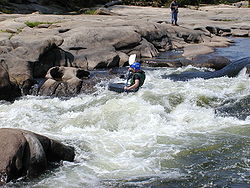 Whitewater kayaking is the sport of paddling a kayak on a moving body of water, typically a whitewater river. Whitewater kayaking can range from simple, carefree gently moving water, to demanding, dangerous whitewater. River rapids are graded like ski runs according to the difficulty, danger or severity of the rapid. Whitewater grades (or classes) range from I or 1 (the easiest) to VI or 6 (the most difficult/dangerous). Grade/Class I/1 can be described as slightly moving water with ripples but for that reason is not considered ‘Whitewater.’ Grade/Class II/2 can be described as moving water providing some small degree of challenge.
Whitewater kayaking is the sport of paddling a kayak on a moving body of water, typically a whitewater river. Whitewater kayaking can range from simple, carefree gently moving water, to demanding, dangerous whitewater. River rapids are graded like ski runs according to the difficulty, danger or severity of the rapid. Whitewater grades (or classes) range from I or 1 (the easiest) to VI or 6 (the most difficult/dangerous). Grade/Class I/1 can be described as slightly moving water with ripples but for that reason is not considered ‘Whitewater.’ Grade/Class II/2 can be described as moving water providing some small degree of challenge.
River running
River running can be thought of as a tour down a river in Ireland, to enjoy the scenery as well as experiencing challenging whitewater. River running includes short day trips as well as longer multi-day trips. Multi-day kayak trips often entail the use of gear-toting rafts to allow a more comfortable experience without a heavily-laden kayak. Downriver or ‘Wildwater’ racing is the competitive aspect of this category, racing canoes or kayaks down a river as fast as possible.
Creeking
Creeking is perhaps best thought of as a subcategory of river running, involving very technical and difficult rapids, typically in the Grade/Class IV to VI range. While people will differ on the definition, creeking generally involves higher gradient (approaching or in excess of 100 ft per mi (19 m per km)), and is likely to include running ledges, slides, and waterfalls on relatively small and tight rivers, though some will allow for very large and big volume rivers in their definition. Kayaks used for creeking usually have higher volume (more gallons or liters of displacement) and more rounded bow and stern, as these features provide an extra margin of safety’ against the likelihood of pinning (getting a kayak wedged in such a way that it cannot be removed without a mechanical advantage system, such as between rocks and/or underwater), and will resurface more quickly and controllably when coming off larger drops. Creek boats usually have increased “rocker,” or rise, fore and aft of the cockpit for manouverability. Extreme racing is a competitive form of this aspect of whitewater kayaking, in which kayakers race down steep sections and or generally dangerous sections of whitewater.
Whitewater slalom
Slalom is a technical competitive form of kayaking, and the only whitewater event to appear in the Olympic Games. Racers attempt to make their way from the top to the bottom of a designated section of river as fast as possible, while correctly negotiating gates (a series of double-poles suspended vertically over the river). There are usually 18-25 gates in a race which must be navigated in sequential order. Green gates must be negotiated in a downstream direction, red gates in an upstream direction. The events are typically conducted on Grade/Class II to Grade/Class IV water, but the placement of the gates, and precision necessary to paddle them fast and “clean” (without touching a pole and adding 2 seconds to the total time), makes the moves much harder than the water’s difficulty suggests. (Slalom has been described as performing class V moves with class III consequences.)[who?] Pro level slalom competitions have specific length (350 cm (140 in) for kayaks – new rules), width, and weight requirements for the boats, which will be made out of kevlar/fiberglass/carbon fiber composites to be light weight and have faster hull speed. Plastic whitewater kayaks can be used in citizen-level races.
Playboating
Playboating, also known as Freestyle or Rodeo, is a more gymnastic and artistic kind of kayaking. While the other varieties of kayaking generally involve going from Point A to Point B, playboaters often stay in one spot in the river (usually in a hole, pourover or on a wave) where they work with and against the dynamic forces of the river to perform a variety of maneuvers. These can include surfing, spinning, and various vertical moves (cartwheels, loops, blunts, pistol and donkey flips, and many others), spinning the boat on all possible axes of rotation. More recently, aerial moves have become accessible, where paddlers perform tricks having gained air from using the speed and bounce of the wave. Kayaks used for playboating generally have relatively low volume in the bow and stern, allowing the paddler to submerge the ends of the kayak with relative ease. Competitions for playboating or freestyle are sometimes called whitewater rodeo in the US, but more frequently just referred to as freestyle events in UK and Europe. Some famous Playboaters are Alex McKay and Ben Catton.
Squirt Boating
Squirt boating incorporates the use of low-volume boats to perform special moves in whitewater features. Squirt boating predates, and was critical to the foundation of, playboating. Squirt boats are often fairly long and flat, with low volume throughout the design. Because squirt boats are custom built to the paddlers weight, inseam, and personal preference, they are constructed with composite materials instead of plastic. Many squirt moves are intended to submerge all or part of the craft and paddler, such as the “mystery move,” in which both the boat and the paddler submerge completely into the river’s flow for several seconds and up to half a minute.
